
Tapeworms In Dogs: Symptoms, Causes & What You Can Do About It
The most common tapeworm affecting cats and dogs is known as Dipylidium caninum. These minute parasites can be identified by their flat appearance, which can be likened to a sewing tape measure. Tapeworms depend on their host and can only survive in the comfort provided by an animalís intestines. To travel from one host to another, these worms rely on yet another parasite to spread from host to host: the common flea.
Despite their lanky composition, each worm is composed of very tiny segments that extend between 3 and 5 millimeters in length. Though not fatal, these parasites can be extremely irritating and can cause your pet to develop persistent gastrointestinal distress. Furthermore, tapeworms are capable of being spread from pets to humans, though such occurrences are extremely rare. In any event, itís ideal to prevent or treat tapeworms before they cause any serious health problems to you or your pet.
Prevention
The best way to prevent a tapeworm infestation is to repel fleas from your pet with preventive flea medications. For dogs, this means ensuring that either your pet dons a potent flea collar or is up-to-date on their monthly topical preventive. Four ingredients are commonly used to prevent flea infestations on dogs: fipronil, s-methoprene, permethrin, and imidacloprid.
Fipronil and permethrin are among the most common ingredients used to combat external parasites- including fleas, ticks, biting flies, and mosquitoes. Medications with fipronil are generally preferred for pets living in households with cats, as those that utilize permethrin can prove toxic to felines. Medications that use permethrin, however, tend to be more effective at keeping the pests at bay.
Preventives that utilize fipronil include Frontline Plus for Dogs, PetArmor, and Effitix. Effitix, however, also utilizes permethrin- the central ingredient in popular medications like Vectra 3D and K9 Advantix II. Preventing coprophagia can also help ensure that your pet does not become infested by consuming an infected stool that contains tapeworm fragments and larvae, or tapeworm eggs.
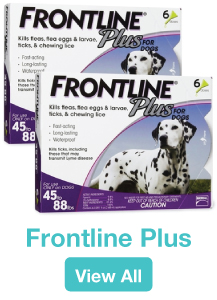
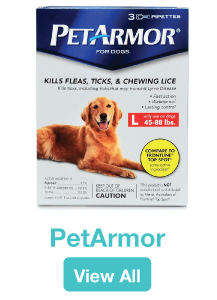
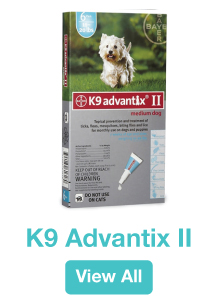
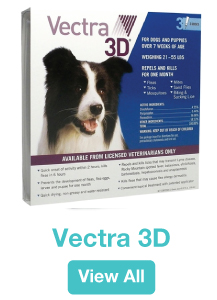

Symptoms & Diagnosis
The typical warning signs of a tapeworm infestation include diarrhea, weight loss, and stomach upset. You might see your dog licking his back or scooting, which are indications of the irritation these parasites cause. Vomiting may also occur once the tapeworm segments reach the inside of your pet's stomach. Pets experiencing these symptoms may also pass small tapeworm segments which are sometimes visible in their stools or vomit.
Tapeworm segments are only passed through your petís system intermittently, making infestations difficult to diagnose and often missed by routine fecal examinations. Because of this, veterinarians will often rely on help from the pet owner to identify tapeworm infestations. Pet owners believing their pet to be infested with tapeworms should check stool and vomit for small, rice-like particles present in a petís stool or vomit. These particles are tapeworm segments that appear white or gold in color and should be collected and brought to the veterinarian for a definite diagnosis.
Causes
Dipylidium caninum and Taenia pisiformis tapeworms are spread via the consumption of an infected flea. In rare circumstances, however, Taenia and Echinococcus tapeworms can be transmitted through small animals that larger, more voracious dogs may ingest. These small animals include mice, rabbits, and birds. Any animal which houses the immature forms of tapeworms or tapeworm eggs before passing them on to their primary hosts are known as intermediate hosts.
Each tapeworm belongs to the class of cestoda; because of this, tapeworms are commonly referred to as cestodes. Though there are even more types of cestodes that can be classified as tapeworms, such as the beef tapeworm- T. saginata, these species nearly never infest canines. When a dog consumes an intermediate host, he also swallows the tapeworm larvae that inhabit it. The larvae of tapeworms capable of maturing in dogs can then grow to lengths of up to 8 inches long inside the intestines.
Treatments
The safest thing to do is to check with a vet to get the correct medication and dosage for your pet. Some pet owners have tried pumpkin seeds and Oregon grape to treat worms, which are known to help expel parasites when given in certain amounts. The amino acid cucurbitacin is found in pumpkin seeds and paralyzes the worms, which can lead to their expulsion from your petís system. Oregon grapes contain berberine, which has been shown to help expel worms as well.
Though these remedies remove some of the worms in your pet, tapeworm infestations can often reoccur if not treated properly. Praziquantel is frequently used to deworm cats and dogs suffering from tapeworm infestations and can be administered as either a shot or as a pill. Praziquantel is the primary ingredient of the popular product Tape Worm Tabs, which can eliminate tapeworm infestations adult dogs and puppies as young as 4 weeks of age.

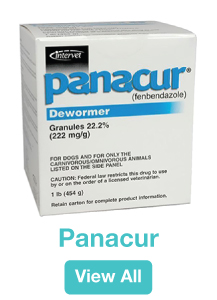
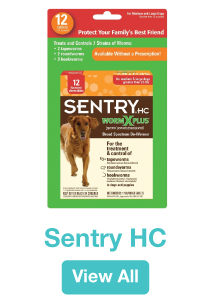
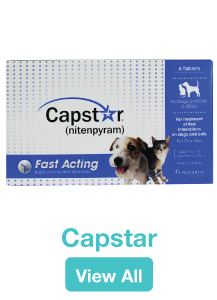
Fenbendazole is also used to treat tapeworms in dogs in medications such as Panacur C. Fenbendazole is an organic compound and actually works to combat a wide variety of parasites that plaque the gastrointestinal tract. Fendendazole is safe for pregnant dogs and features an impressive shelf-life which leaves it capable of lasting up to 3 years- making it the ideal choice for accommodating a regular deworming schedule.
To prevent reinfestation, itís also important to ensure that your pet is free of fleas, which can be accomplished with any of the preventive flea treatments mentioned earlier in this article. For pets that are already infested with fleas, flea treatments such as Capstar can work in conjunction with topical flea preventives to kill fleas quickly without causing health complications in your pet.
In any event, it is important that you follow your veterinarianís instructions and administer any medication exactly as directed.
